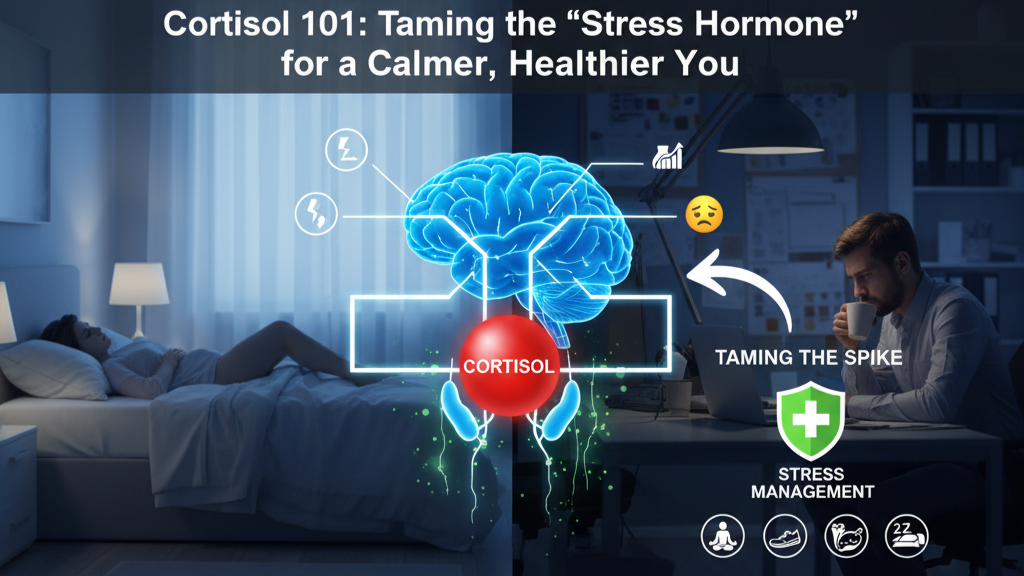Cortisol 101: Taming the “Stress Hormone” for a Calmer, Healthier You

We’ve all heard of the “stress hormone,” a mysterious chemical that gets blamed for everything from belly fat to burnout. That chemical is cortisol, and while it often gets a bad rap, it’s not the villain it’s made out to be.
Think of cortisol as your body’s built-in alarm system and energy manager. It’s a crucial player that helps you wake up in the morning, gives you a burst of focus for a big meeting, and plays a key role in reducing inflammation. But when the alarm gets stuck in the “on” position, this helpful hormone can start to cause problems.
So, let’s pull back the curtain on cortisol. Understanding how it works is the first step toward learning how to manage it—and reclaiming your sense of balance.
The Cortisol Rhythm: Your Body’s Natural Rise and Fall
Under normal circumstances, cortisol follows a daily pattern. Levels are highest in the morning, right around 8 AM, which helps you feel awake and ready to tackle your day. Throughout the day, these levels gradually decline, reaching their lowest point around midnight to allow for restful sleep.
This entire process is run by a sophisticated command chain in your brain known as the HPA axis (Hypothalamic-Pituitary-Adrenal axis).
Imagine this:
- Your hypothalamus is the CEO, monitoring your body for threats.
- If it senses stress (a looming deadline, a heated argument), it sends a memo to the pituitary gland, the general manager.
- The pituitary gland then orders the adrenal glands (two little glands sitting on top of your kidneys) to release cortisol.
This system is brilliant for short-term crises. Cortisol floods your body with glucose (energy), sharpens your focus, and puts non-essential functions on hold. The problem is, in our modern world of chronic stress—traffic, work pressure, endless notifications—the CEO is constantly sending out emergency memos, and the cortisol tap never fully shuts off.
When the Alarm Won’t Stop: The Effects of Chronic High Cortisol
When cortisol levels are constantly high, your body is stuck in a state of high alert. This can disrupt nearly every system in your body and may lead to:
- Weight Gain: Cortisol can increase your appetite, especially for high-sugar or high-fat foods, and encourages your body to store fat, particularly around the abdomen.
- Sleep Problems: High evening cortisol can leave you feeling “wired and tired,” making it difficult to fall asleep and stay asleep.
- A Weakened Immune System: Over time, cortisol can suppress your immune system, making you more susceptible to colds and other illnesses.
- Brain Fog and Mood Swings: It can interfere with memory, focus, and emotional regulation, leaving you feeling irritable, anxious, or foggy.
- Increased Blood Pressure: Cortisol constricts blood vessels and makes your heart beat faster, which can lead to hypertension over the long term.
Feeling discouraged? Don’t be. You have more power over your cortisol levels than you think. You don’t need a complicated plan; you just need to send your body consistent signals of safety. Here are five natural ways to do just that.
5 Natural Ways to Lower Your Cortisol
1. Go for a “Calm” Workout, Not a “Stressful” One
Intense, long-duration exercise can actually be seen as a stressor by your body and temporarily raise cortisol. For lowering stress, focus on moderate, restorative movement.
- What to try: A brisk walk (especially in nature), a yoga class, Tai Chi, or a relaxed bike ride. These activities help your body burn off nervous energy without sending your stress response into overdrive.
2. Master the Art of the “Slow Down”
You can directly counteract your body’s stress response by activating its “rest and digest” system.
- What to try: Deep belly breathing. Inhale for a count of four, hold for four, and exhale for a count of six. A few minutes of this can send a powerful message to your HPA axis that the danger has passed. Other proven methods include mindfulness meditation and journaling.
3. Prioritize Your Sleep—No Excuses
Sleep is when your body does its most important repair work and resets its hormonal cycles. Poor sleep is a major trigger for high cortisol.
- What to try: Create a relaxing wind-down routine. Dim the lights an hour before bed, avoid screens (the blue light disrupts sleep hormones), and try a warm, non-caffeinated drink like chamomile tea. Aim for 7-9 hours of quality sleep per night.
4. Fuel Your Body with Anti-Stress Foods
The food you eat can either fuel the stress cycle or help tame it. High-sugar foods and refined carbs can spike and crash your blood sugar, which puts stress on your system.
- What to try: Focus on whole foods rich in Vitamin C (citrus fruits, bell peppers), magnesium (leafy greens, nuts, seeds), and Omega-3 fatty acids (fatty fish like salmon, walnuts). And don’t forget to stay hydrated with plenty of water.
5. Cultivate Joy and Connection
Positive social interactions and genuine laughter are incredibly powerful cortisol reducers.
- What to try: Schedule a phone call with a good friend. Spend quality time with a pet. Watch a truly funny movie. These activities trigger the release of oxytocin, a hormone that promotes bonding and has a direct calming effect on the body, effectively lowering cortisol.
By incorporating these simple practices into your life, you can help your body’s alarm system learn the difference between a real emergency and a daily hassle, bringing your cortisol levels—and your life—back into healthy, calm balance.



